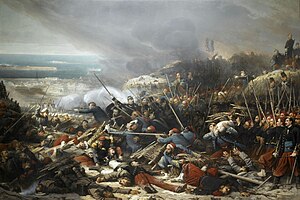Odurian War
This article is a work-in-progress because it is incomplete and pending further input from an author. Note: The contents of this article are not considered canonical and may be inaccurate. Please comment on this article's talk page to share your input, comments and questions. |
| Odurian War | ||||||||
|---|---|---|---|---|---|---|---|---|
 The Siege of Oduria (1860). Oil on canvas. | ||||||||
| ||||||||
| Belligerents | ||||||||
|
|
|
| ||||||
The Odurian War was a conflict in Vallos that led to the final partition of the Kingdom of Oustec. The war began obstensibly as an intervention into Oustec by Caphiria to protect the community of Latin-speaking cities there. The unification of Burgundie created it as a strong, Levantine colonial power with extensive possessions bordering Oustec. Its presence sparked a period of fear and panic in Caphiria regarding Levantine Creep and the fate of the Latins in the country. The sudden invasion of eastern Oustec on 18 March 1858 prompted a counter-invasion of the rest of the country by Burgundie in July, fearing that Caphiria might annex the entire rump Kingdom. In August, the estranged Harounan Province declared independence from the crumbling Oustec state and sought protection from Urcea, whose forces in New Archduchy were well positioned to arrive at the Harounan Province in a timely manner. The Oustec, unable to resist invasion from three sides, pulled most of their forces back to their inland capital city of Oduria. Oduria was besieged by Burgoignesc forces for much of 1859 before finally falling towards the end of the year. The conflict threatened to escalate into a general conflict involving the three Occidental powers before Kiravia brokered a peace.
Name
The conflict is named for Oduria, the last capital city of the rump Kingdom of Oustec. The primary fighting involving Levantine forces centered around the Burgoignesc campaign around the city, popularizing the name in the Levantine press. During the early 20th century, the conflict was referred to as the "Vallosi Latin Salvation War" in Caphiria, a name which gradually lost public use in favor of the international name for the war.
Background
Caphiric invasion
Burgoignesc counter-invasion
Siege of Igko
As an initial stage of its offensive, Burgundine forces attacked and blockaded the island of Igko, at the northern end of the Capelranco Archipelago. The second largest military port in Oustec, Igko resisted initial attacks and as a result was besieged by Fanerian naval forces operating in support of Burgundie. Igko remained besieged until October of 1859, but not without a breakout attempt in July in conjunction with a relief force in what became the Battle of Corubia. The Battle of Corubia was the second naval engagement to include ironclads by less than a month, with the armored Seba and Gwaeron proving instrumental in the resulting Occidental victory.
Aronese secession
Fall of Oduria
Peace
After the fall of Oduria and collapse of the remaining Oustec holdouts, a period of uncertainty existed in northern Vallos. Low level skirmishing between all three Occidental sides had occurred at the periphery of each nation's area of interest, and in all three countries there was some political appetite for a more extensive war to determine the fate of the entire former Oustec Kingdom. In order to prevent a general Occidental conflict, Kiravia intervened and offered itself as an arbitrator on 1 December 1859, threatening to otherwise involve itself to protect stability in the St. Brendan's Strait area. Diplomats from Urcea, Caphiria, and Burgundie traveled to Kiravia that December to begin peace negotiations.